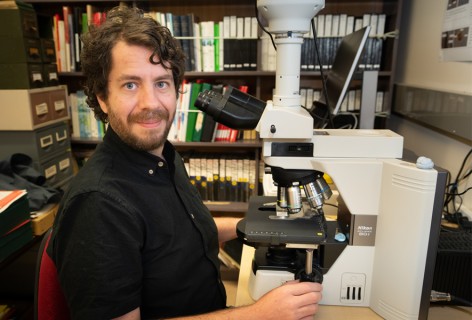The story begins with two ancient bird coprolites – fossilised poo – collected several years ago from dry caves in two remote locations in New Zealand’s South Island beech forests. Coprolites can be carefully picked apart and analysed for DNA and microscopic remains to find out what species of birds deposited them and what they ate. Studying ancient bird coprolites helps to reconstruct what ecological roles extinct birds used to play in shaping New Zealand’s ecosystems before they died out.
Initially included in a study of kakapo droppings, the ancient poos turned out to be from the upland moa. Weighing less than 50 kg, this species was one of the smaller members of at least nine species of moa (the larger members reaching over 3m tall and 250 kg in weight). This guild of birds were flightless, herbivorous, ground-dwelling birds that all went extinct around 600 years ago.
Rather than put the coprolites back in the specimen box, the scientists took the opportunity to fully analyse them, with some surprising results.
Truffle-like fungi have fruiting bodies that never fully open and lack a way to eject their spores. Whereas other fungi do this by wind, the truffle-like fungi rely on animals to consume them and disperse their spores. Overseas such fungi – including “true” truffles – are generally drab, strong-smelling and highly appealing to mammals. By contrast, those in New Zealand are often brightly coloured and look very much like fallen berries on the forest floor.
It is likely that these fungi depended on fruit-eating birds for their dispersal, yet there is little evidence that any present-day native birds eat them. Ecologists have long debated that their original dispersers must be extinct birds, but this has never been demonstrated before now.
Previous work on coprolites has already shown that the extinct moa ate brightly coloured fruits and other plant matter, but the new analyses revealed that moa were indeed consuming these colourful truffle-like fungal species. This finding adds weight to the idea that these fungi had evolved specifically to be attractive to fruit-eating birds. Moa would have been good at dispersing the fungal spores, too – comparison with their distant cousin the ostrich, which retains food for some 36 hours after eating it, shows that moa could have carried spores in their gut over long distances.
But given the large birds are extinct, what if anything is now driving the dispersion on which these fungi once depended? What will eventually happen to these evolutionary anachronisms – species that rely on other species to establish and thrive that are no longer there? Further, how is this loss likely to affect current native forest resilience and its capacity to regenerate and expand?
The scientists say it’s unlikely that remaining species of herbivorous ground-dwelling birds, such as weka, can make up for the loss of moa in dispersing these fungi. In turn, this may be having knock-on effects on overall forest resilience to this day. Forest species such as New Zealand beeches have evolved symbiotic relationships with native fungi, such as the ones detected in the moa poos, to benefit their regeneration and resilience, so fewer or less widespread native fungi in the mix may decrease forest resilience overall.
Are non-native mammals such as possum or deer able to take the place of the moa? No, say the scientists: scent-driven mammals are not so interested in non-odorous, fruity fungi that evolved to catch a ground-dwelling bird’s eye, and native fungal spores also don’t survive so well in the mammal gut. Instead, non-native mammals tend to disperse non-native fungi, which in turn promote symbiotic relationships with non-native forest species, at the expense of native ones, with possible flow-on effects on native forest resilience.
More study is needed as this gradual turnover of fungal communities continues. What is clear, the scientists conclude, is that the long-term consequences of moa loss on the overall health of native ecosystems are still very much unfolding, some 600 years down the track.

